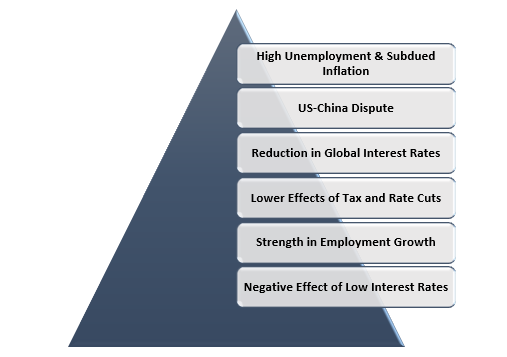Amidst global trade tensions and mounting recession pressure, RBA recently lowered the domestic interest rates further to 0.75 per cent. In its recently released October meeting minutes statement, the RBA has discussed the concerns that led to this 25 basis points rate cut in October, and has conveyed its readiness to ease monetary policy further to boost growth and jobs.
Let us discuss the considerations for the RBA?s October monetary policy decision below:
High Unemployment & Subdued Inflation
The major reasons that induced the RBA to reduce interest rates to 0.75 per cent, were high unemployment and subdued inflation. The RBA board members noted that the unemployment rate had continued to be high at 5.25 per cent since April and the underemployment rate had stayed higher than its recent low point.
Along with the unemployment rate, the inflation figures in Australia have not been so promising in the last few months, with the country?s inflation being below its target range.
The central bank observed that its earlier forecasts that suggested the likelihood of inflation and the unemployment outcomes to remain short of the RBA?s goals over the next couple of years, has not been altered. The current subdued rate of wages growth implied the existence of spare capacity in the Australian labour market.
US-China Dispute
The RBA board members observed the downside risks to the global growth outlook, emerging from the technology and trade disputes between the US and China. The bank noted that the disputes were impacting investment and international trade, as businesses revised down their spending plans owing to increased uncertainty. These tensions had resulted in a shrinkage in bilateral trade between the US and China.
The US and China have been indulged in a trade dispute for the last 15 months, imposing tit-for-tat tariffs on each other and affecting economies across the world. The two countries have entered into a partial trade deal recently, reviving hopes of a trade truce. However, some market analysts are warning over risk of a tariff escalation without a permanent dispute settlement mechanism in position.
Reduction in Global Interest Rates
The RBA observed a decline in interest rates across the globe, with the US and Europe central banks reducing interest rates in September.
Owing to persistent downside risks, the US Federal Reserve lowered its policy rate by 25 basis points in the previous month. The members of the Federal Open Market Committee also signalled for a further easing of monetary policy if necessary, to sustain growth and meet inflation objective. The financial markets are pricing a further 50 basis points by mid-2020, a little less than the previous projection.
The European Central Bank (ECB) has also reduced its policy rate by 10 basis points to negative 0.5 per cent, in response to protracted weakness in economic growth, the persistence of inflation below the ECB's target and continued downside risks.
The minutes showed that the central banks across the world are responding to the global downside risks and subdued inflation. The RBA also observed record low long-term government bond yields in many countries, including Australia.
Lower Effects of Tax and Rate Cuts
Although the Federal Government successfully passed its $158 billion income tax cut package in July, the RBA did not see any stimulatory effects from its two previous rate cuts in 2019. As per the RBA, there has not been any evidence of an improvement in household spending with the receipt of the tax offset payments and previous reductions in the cash rate.
The RBA board members recognised that the effects of the income tax cut and rate cuts may be smaller than expected, and may boost growth in future, given the turnaround in the established housing and mining sectors.
Strength in Employment Growth
Discussing the strength in employment growth, the RBA mentioned that the robust employment growth had not lowered spare capacity in the labour market considerably. In August, Australia witnessed a higher growth in employment relative to the expansion in the working-age population, with the employment-to-population ratio touching its peak point since late 2008.
The bank noted that the strength in employment growth had been balanced by higher participation over the preceding three years, resulting in a little progress on diminishing underemployment and unemployment. The RBA recognised the possibility of a partial rise in participation rates pursuant to weak growth in incomes.
Australia also observed a decline of 1.9 per cent in job vacancies in August 2019 quarter. The RBA expects a moderation in the employment growth over the subsequent few quarters, owing to the decline in job vacancies.
Negative Effect of Low Interest Rates
The RBA also revealed concerns that could arise by taking interest rates to such a low level. The bank noted the adverse effects of low interest rates (0.75 per cent) on the confidence and income of savers in the minutes.
The bank expressed its concern that the lower interest rates could result in overly inflated property prices as banks pass on their reduced borrowing costs via lowered mortgage rates.
The RBA members also discussed the possibility of less effect of policy stimulus, with some transmission channels like the effect on the home-building sector and a pick-up in borrowing, not operating in the same way as in the past.
The board noted that some monetary stimulus should be held in reserve to deal with any negative shocks in future. However, the minutes highlighted that the changes in interest rates have been a more important determinant of demand than the level of interest rates.
The bank stated that the likelihood of a negative shock could be reduced by strengthening the beginning point for the economy.
Despite concerns over over-inflated housing prices and weakening confidence of savers, the RBA had cut the interest rate to 0.75 per cent in October.
Post the release of the RBA minutes, economists have revised their predictions of November rate cut, not expecting any reductions until February next year. The forecasts were amended after the RBA highlighted the negative effects of lower interest rates on households and savers.
Disclaimer
This website is a service of Kalkine Media Pty. Ltd. A.C.N. 629 651 672. The website has been prepared for informational purposes only and is not intended to be used as a complete source of information on any particular company. Kalkine Media does not in any way endorse or recommend individuals, products or services that may be discussed on this site. Our publications are NOT a solicitation or recommendation to buy, sell or hold. We are neither licensed nor qualified to provide investment advice.





